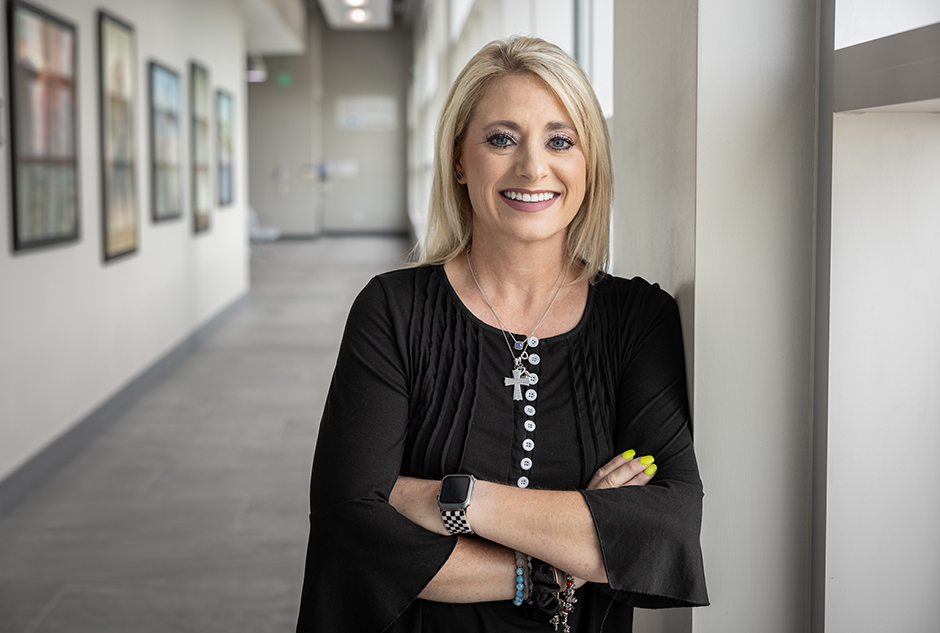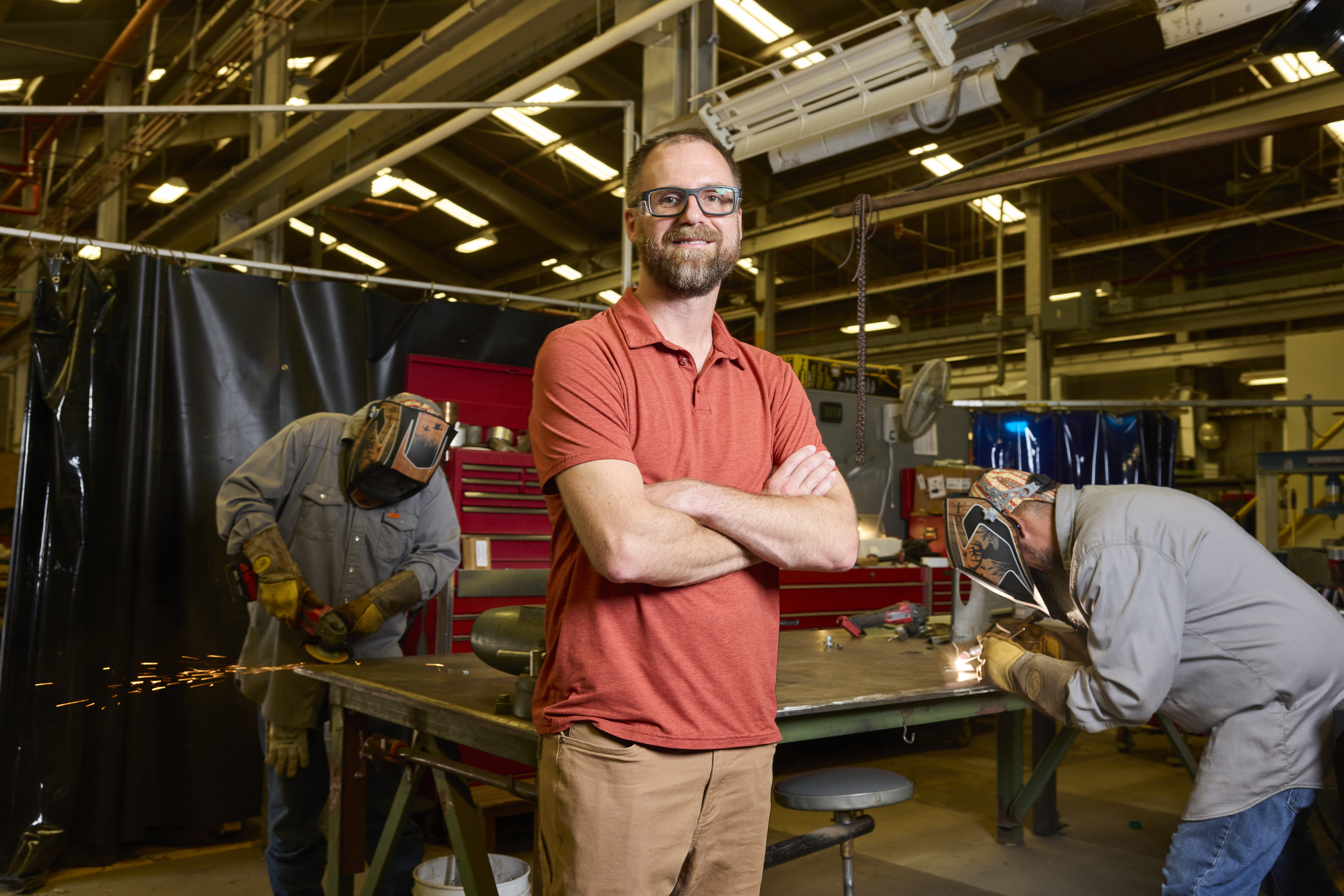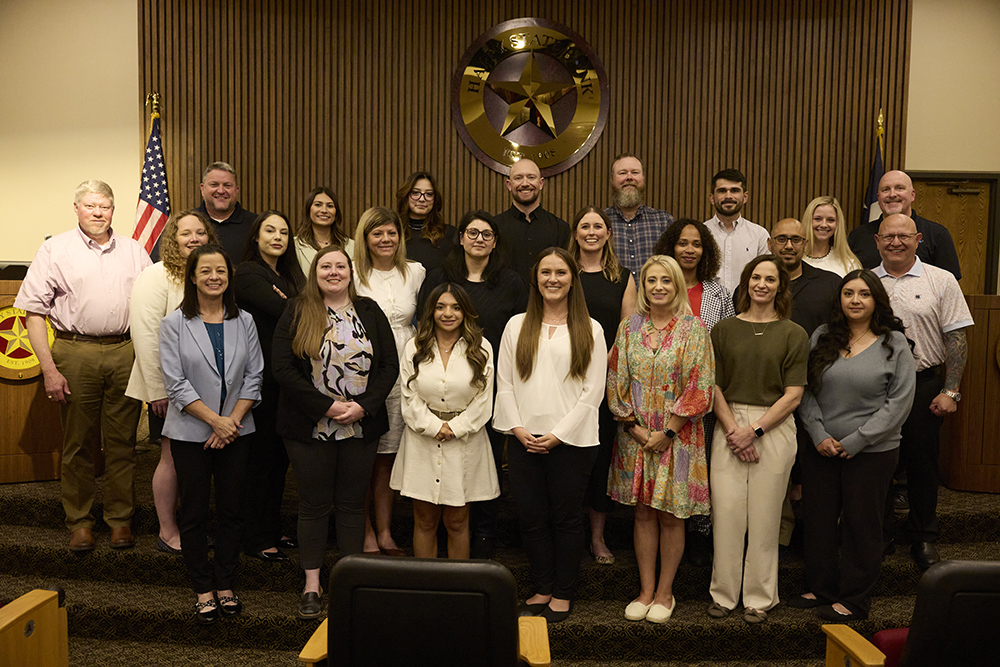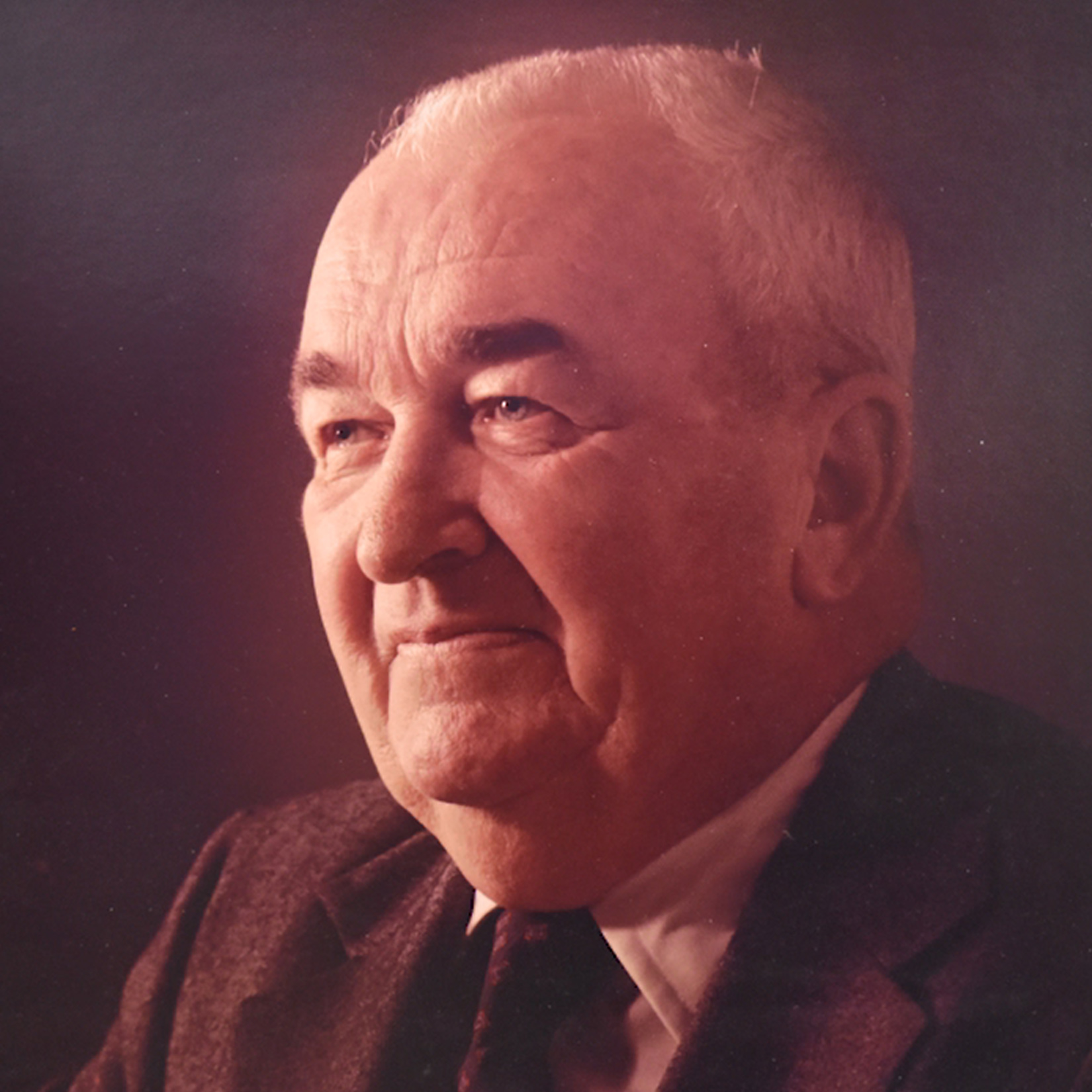Pantex Blog
A-mazing training
Firefighters recently completed training using a large maze to solve complex challenges and reinforce problem-solving skills.
The task seems simple — to complete the training, firefighters must maneuver a ball through a maze without touching the ball. It’s like a life-sized game of labyrinth, but instead of knobs that move the board, the first responders manipulate a large table using various emergency response tools. Throughout the exercise, the height of the maze is adjusted and firefighters “crib” the table, or stabilize it, at the new height. Cribbing uses wooden or plastic blocks to create a solid support structure and is commonly used during rescue operations.
“This training better prepares members when it comes to lifting thousand-pound vehicles while ensuring safe operations,” Captain Joshua Brown said. “It reinforces the need to crib as you lift and sparks creativity in problem-solving. It’s more than just a maze, it is interactive training designed to reinforce and build upon essential firefighting principles in a practical and engaging manner.”
Groups of firefighters navigate complex paths in the maze to continuously improve on lifting techniques, stabilization skills, and the use of diverse tools. Firefighters communicate and coordinate with multiple team members to accomplish the mission.
“A core principle of this training approach is that learning is most effective when it is enjoyable and engaging,” Brown said. “The maze, with its challenging scenarios and timed competition, transforms routine drills into enjoyable experiences. This element of ‘fun’ in training is not merely a byproduct; it is intentional. When individuals are invested and find enjoyment from their training, retention of knowledge and skill development are significantly enhanced.”
The maze training encourages critical thinking and creative problem-solving among peers. Each team adopted a different approach and used various tools to complete the exercise. Some teams spent over an hour completing the maze due to trial and error, but with each passing minute, skills were sharpened, equipment proficiency gained, and obstacles overcome. The timed element of the training added a sense of urgency to adjust and persevere.
“This training underscores the value of recognizing and adapting effective training methodologies within the Pantex Fire Department,” Brown said. “PXFD exemplifies a culture where imagination is embraced and tailored to accomplish a specific need that directly addresses training objectives.”
Life isn’t a game, but the skills learned from this puzzle could save lives. Interactive, hands-on training like this fosters proactive skill building and encourages enhanced safety and effectiveness during emergency response.
Pantex Proud: Kela Boyett

Thousands of dedicated Pantex citizens like Kela Boyett work every day to support the Pantex mission. Take three minutes to learn about who she is, what she does, and why she is proud to be a Pantexan.
When Kela Boyett was young, she told herself she’d never work at Pantex. With a father who worked at Pantex for more than 39 years, plus aunts, uncles, and cousins who were Pantexans, Kela Boyett considers herself a Pantex “legacy kid.”
While the temptation to rebel against the Pantex family heritage was real, ultimately, 15 years ago the opportunity came to apply for a job at Pantex, and she decided to take it.
“I thought I was going to go to law school and work in a law firm in Amarillo, but I began to think that Pantex could be a stepping stone to bigger and better opportunities,” Boyett said.
Boyett started out as an executive assistant, then moved to being a production planner before landing in Legal as an export compliance lead analyst.
“I quickly found that Pantex is more than what I thought — it is about protecting America,” she said.
“I’m proud to support the biggest mission there is. I also realized that Pantex is a little community where everyone knows each other and is proud to say, ‘I am a Pantexan.’”
As a production planner, Boyett learned the ins and outs of the plant and the importance of the nuclear security mission. When she joined Legal, she desired to play her own part in protecting America through safeguarding sensitive information from would-be adversaries.
As the export compliance office lead analyst, Boyett ensures both information or items leaving the site do not include anything that should not be shared externally or across borders.
“My job ties to Operations Security, Classification, Counter Intelligence and many other divisions when making decisions on export and Information Release Office determinations,” Boyett said. “This job has given me the opportunity to bring awareness to the plant population on what can and can’t be shared with others, how we have to dispose of materials and information, and what the implications are if we don’t follow laws and regulations.”
You could say Boyett is now converted to the Pantex cause.
“It’s truly a ‘family affair’ and I’m proud to say that carrying on my family’s legacy here at Pantex means the world to me,” she said. “I’ve always been known as Dennis Arney’s daughter, and that makes me very proud.”
What work advice would you offer someone who is new to Pantex?
Smile, make eye contact, say hello, and good morning. The people you interact with at work sometimes see you more than your family. Form good solid relationships with your co-workers and make sure that you are approachable. I think it’s always good to start with a smile in the hallways and say “good morning.”
What advice would you offer a newer employee about the importance of solving problems and asking questions?
Pantex as a whole is very overwhelming. There are so many acronyms, and some are used for multiple things which can get confusing. It takes time to learn and distinguish the difference. Ask questions when you’re unsure. Unfortunately, ignorance is not bliss at Pantex and can land you in a bit of trouble, so never ever feel afraid to ask for help. Most of the time you are met with a smile and a willing heart.
What’s your favorite outside-of-work activity?
My favorite activities are watching my son race his go-kart, seeing my daughter playing volleyball, and watching my husband drive his race car. Racing is in my blood. My dad raced stock cars and late models for years. I knew that when I had a son, I wanted him to carry on that legacy and he has not disappointed. I’m excited to spend my weekends watching them race.
Welding recognition brings greater awareness to Pantex mission

Pantexan Jason Trosen’s role with the American Welding Society demonstrates the welding knowledge and experience he shares with his colleagues.
In the 2008 blockbuster “Iron Man,” the titular character found himself in an Afghan cave with a chest full of shrapnel and surrounded by terrorists. He had limited options, but he possessed a keen intellect and no shortage of scrap metal.
That character, Tony Stark, had one additional skill that facilitated his freedom — he was a master welder.
Pantex, of course, is not Afghanistan. Employees leaving for the day aren’t dodging shrapnel as they head for BN5A, and the plant’s Protective Force stands ready to ensure any terrorist foolish enough to set foot on the site would have a very, very bad day.
But, Pantex does have an Iron Man of sorts, a welding expert who shares his knowledge with others and who has now garnered recognition and leadership among an industry standards group.
“Jason Trosen is a world-class welding engineer who could have his pick of jobs anywhere in the world,” explained his supervisor, Projects Engineering Manager Billy Baker. “He has helped bring on three additional welding engineers since joining the team. The current welding team is a group of young engineers who love what they do and are dedicated to making the welding program and the mission of Pantex successful. Jason is an integral part of that success.”
Just as Tony Stark was no loner-type action hero, Trosen credited others for his involvement with the American Welding Society (AWS).
“In 2023, Rich Campbell, who was a vice president and lead of the welding program at Bechtel, performed a parent-company audit of our welding program,” he explained. “Rich is very involved in various code committees and encouraged Pantex to get involved as well. He invited me to attend the next AWS D1 meeting that fall. I got involved with writing some code updates. Last fall, I was asked to serve as the vice chairman of the Materials Task Group.”
Trosen went on to explain the D1 Committee is responsible for establishing welding standards for structural integrity. It comprises numerous subcommittees, each with an assigned area of responsibility. The group Trosen helps lead includes engineers, scientists, metallurgists, manufacturers, and fabricators. His group is responsible for adding new materials to welding codes and recategorizing materials within existing code. While Trosen’s involvement is an undeniable feather in his cap, he continued to focus on those who’ve shared his career adventures and guided him along the way.
“My dad has always been a big encouragement to me in my career,” Trosen said. “He started his career as a welding engineer as well, so we have a lot in common.”
Trosen’s role with the AWS promotes awareness of Pantex, too.
“Jason’s involvement in the AWS D1 Committee brings national visibility to the mission of Pantex within the welding industry and provides him — and, subsequently, the plant — valuable insight into where the welding industry is going and how we can better prepare for changes that may come from developments in the code,” Baker said.
Trosen agreed.
“Involvement in code committees allows Pantex to have visibility of upcoming changes to the codes to which we work as well as a voice in those changes,” he said. “It also gives us great contacts to leaders in the industry. In one meeting I attended, we had recently been through a Defense Nuclear Facilities Safety Board audit where a code interpretation question had come up and I was able to talk with the chairman of the committee that wrote that code and get very valuable insight that helped address DNFSB’s concerns.”
In the end, what makes Trosen a Pantex Iron Man is not swooping in to save the day like Tony Stark; instead, it’s sharing what he’s learned so both he and his peers go home each night happy and healthy.
“We have six classes and computer-based trainings where we share knowledge about welding and welding program requirements,” he said. “We regularly work with groups all around the plant to help them understand welding requirements and ensure we meet welding code requirements that are in place to ensure our safety.”
Follow the leader

Pantex Leadership Academy participants pose with senior leaders following a graduation ceremony in the Happy State Bank auditorium at the Pantex Amarillo Campus.
Plus two. It’s not the start of a mathematical equation or the call for more points at a sporting event; instead, plus two is a leadership philosophy focused on identifying the unique strengths of others to achieve success. This leadership style encourages a culture of excellence by elevating others’ strengths, motivations, and passions. After a video and lesson showing plus two in action, the catchphrase quickly became the motto for the first class of the newly imagined Pantex Leadership Academy for Individual Contributors and Aspiring Leaders (PLA IC/AL) held in June.
The PLA IC/AL is part of a multi-tiered initiative to develop future leaders. When PanTeXas Deterrence (PXD) was awarded the managing and operating contract for Pantex, discussions began on developing top talent through a leadership program. Pantex is committed to cultivating talent, not just to fill a role, but to empower people and inspire others to create lasting mission success. The PLA IC/AL was created to act on senior management’s commitment to recruit, retain, and empower the next generation of high performers at Pantex.
“Everyone has a last day at Pantex, including our leaders,” Information System Security Manager and PLA IC/AL graduate Tiffany Lafleur said. “Devoting time and resources to high-performing individuals helps the organization build the next generation. It gives aspiring leaders a safe environment to both build experience and learn from the lessons of current leadership. I left the academy with a renewed confidence and desire to grow because PXD took the time to invest resources in my professional development.”
The PLA IC/AL is a week-long immersive training focused on foundational skills, team dynamics, practical management, and next-level leadership. The Organizational Development and Training team created this course and works to ensure it benefits Pantexans and the plant by developing emotionally intelligent, critical thinkers while encouraging connection with other future leaders.
“This program introduces concepts and information that most personnel aren’t exposed to as individual contributors,” Organizational Development and Training Director Melissa Roy said. “The course focuses on the soft skills that will help you in your journey. My most memorable moment was watching the relationships form and listening to the conversations develop between participants.”
Pantex is committing resources and investing in personal development to build the future of Pantex in its people. Twenty-two Pantex employees, as well as two from the Pantex Field Office, were selected to participate in the academy. The pilot included a project manager, an electrical engineer, a solutions analyst, and other diverse career fields at Pantex. An intentional benefit of the PLA IC/AL is a valuable network of people who care about Pantex’s mission and are determined to lead others with integrity, competency, and service.
“The training was insightful and pushed me to consider concepts I had not really thought about before,” Lafleur said. “Throughout the week, I built relationships with other aspiring leaders and got opportunities to better understand different roles and jobs at the Pantex Plant. These relationships are probably the best part of the program. I left the academy feeling like I was a part of a cohort of professionals that will hold each other accountable and support each other as we navigate growing as leaders together.”
Each training day had a focus — including foundational skills, team dynamics, practical management, next-level leadership, and capstone scenarios. Participants combined learned skills to proficiently work through a variety of situations that are likely to happen in supervisory roles. Participants improved self- and social-awareness, practiced conflict resolution, and built genuine connections through networking. The week culminated with opportunities to interact with senior leaders and a formal graduation ceremony.
“I appreciate the opportunity and am proud to be a graduate of the first cohort,” Lafleur said. “We had time to look at the values we want to hold as leaders and evaluate where we are in those areas. I am excited to see where this program goes in the future and the overall impact it will have on the plant.”
The PLA IC/AL will be held quarterly. If you want to use your talents to further contribute to the Pantex mission through leadership, share your interest with your supervisor. Development opportunities are crucial for sustaining the exceptional workforce Pantex needs to deliver on its national security mission.
John C. Drummond leading the way

John C. Drummond
The building’s initials are mentioned hundreds of times a day around Pantex. The largest and most-populated building at Pantex is commonly referred to as the JCDC, but have you ever wondered how the JCDC got its name?
During construction, site leadership held a Pantex-wide contest while the then-unofficially designated administrative support complex (ASC) was being constructed. Submissions such as “The Triad” or “Pantex Headquarters (PHQ)” were bandied about, along with a handful of other titles or names. But when the final votes were tallied, the runaway winner was John C. Drummond Center (JCDC) to honor the legacy of a beloved Pantexan.
John was born in Boston, Massachusetts, on December 2, 1905. His early career started with a city field engineer position in Boston before he moved to the Boston & Maine Railroad in the late 1920s.
By the early 1930s, John worked for various companies before becoming the superintendent of construction at Mason & Hanger Silas Mason Company during construction of the Merriman Dam at Lackawack, N.Y.
As the United States entered World War II, John was transferred to Minden, Louisiana, as an engineering assistant at a construction site. That site, the Louisiana Ordnance Plant, would be one of the nation’s largest artillery ammunition- and bomb-loading assembly plants. He continued with them as loading line superintendent and then division superintendent.
When World War II ended, John was made a design engineer on projects converting five munitions’ facilities into ammonium nitrate fertilizer plants. He was then assigned to the Wabash River Ordnance Works at Newport, Indiana as project manager of an ammonia oxidation and neutralizing plant. By July 1947, John was on the move again, assigned as assistant chief engineer on a project at the Iowa Ordnance Plant in Burlington, Iowa.
“We moved to Burlington, which was also in the nuclear business, but also in the conventional business,” recalled son Skip Drummond. “And I think dad was on the conventional side up there, wasn’t he?” he asked sister Joan Hood.
“Well, to start with,” Joan confirmed. “We went to New Mexico and California. And then back to Kansas City to learn about the places that were involved in nuclear weapons, and because the company had visions of coming back and winning this contract, and later to the Fort Randall Dam outlet works and tunnels job at Pickstown, South Dakota, where he developed a saw carried by rail car to cut into granite for blasting – his last move before coming to Pantex.”
With most of the family’s relocations coming to an end, the Drummonds’ sights were set on the Texas Panhandle.
“Procter and Gamble had the operating contract for the first 5 years that the plant was in business,” Skip said. “Mason and Hanger and dad were here the first time in ‘50, ‘51 and a little bit of ’52 and the rebuilding of the plant was completed.”
John was an instrumental leader in the establishment and growth of the Pantex Plant, creating a legacy that continues today. He arrived at Pantex in 1951 to supervise construction as the Army and Atomic Energy Commission transformed the World War II-era Pantex Ordnance Plant into a nuclear production facility.
“So, in ‘56 Proctor and Gamble, for whatever reason, they wanted out. I think the Atomic Energy Commission just picked Mason & Hanger, whose leaders said to dad, ‘You're familiar with the plant. You helped rebuild it, so we want you to run it.’ Dad spent a lot of time on the line, working closely with everyone, he was always so encouraging. I bet dad knew almost 100% of the people out here and probably knew the names of their wives and some of their kids.”
He served as the Pantex Plant manager from 1956 to 1974, overseeing the expansion of Pantex production during the height of the Cold War with the Soviet Union.
Skip also recalled an endearing nickname from a popular radio and film character that was attached to his dad during his time as manager. That character was known as one of the first true heroic leaders in the entertainment industry.
“You know, there was a fictional detective called Bulldog Drummond. And whoever made that connection, though, and then called him Bulldog. I'm not really sure who called him that first,” Skip said.
“I don't think they called him that to his face.” Joan interjected.
Regardless, the nickname stuck — with good reason.
“But he got the nickname because he took care of the employees,” Joan continued. “And it didn't matter whether it was his son-in-law or whether it was Joe Blow; he took good care of the folks.”
John was very involved with community efforts while leading Pantex. He was vice chairman of the Board of City Development, chairman of the Amarillo’s Civil Service Commission, along with being a board member and trustee for the Amarillo Foundation for Health and Science Education, the Amarillo Zoological Society, and St. Anthony’s Hospital.
Following his retirement from Pantex, John was elected mayor of Amarillo and served from 1975 to 1977. He passed away 5 years later in April 1982.
The JCDC held its open house in 2018, and during that ceremony the 343,000-square-foot, state-of-the-art facility was dedicated as the John C. Drummond Center.
Skip and Joan thought it was the best tribute their father could receive.
“We're a little bit prejudiced, but we think it was a great choice,” Skip said.
